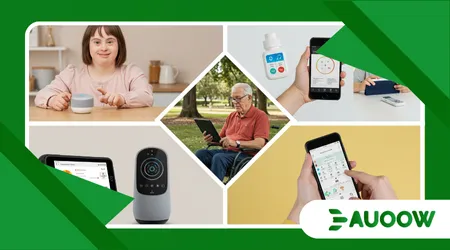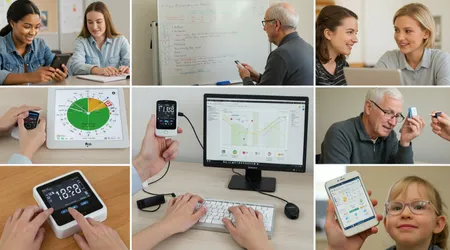Assistive Technology for Cognitive Disabilities: Top Trends

Assistive technology for cognitive disabilities is reshaping how individuals with cognitive impairments engage with the world.
In 2025, innovations in this field are not just tools they’re lifelines, empowering people with conditions like autism, dyslexia, ADHD, or memory impairments to navigate digital and physical spaces with greater independence.
The intersection of artificial intelligence, wearable tech, and inclusive design is driving a revolution, making accessibility a priority rather than an afterthought.
This blog post explores the cutting-edge trends transforming lives, offering practical examples and insights into how these tools bridge gaps in cognition, communication, and daily functioning. Why settle for exclusion when technology can unlock inclusion?
The global push for digital inclusion has never been stronger. According to the World Health Organization, over 2.5 billion people use assistive technology, with cognitive disabilities being a significant focus.
These tools are not only about accessibility but also about dignity, enabling users to thrive in education, work, and social settings.
From AI-driven apps to simplified interfaces, the trends we’ll discuss are grounded in real-world needs, backed by research, and designed to empower.
Let’s dive into the top innovations shaping assistive technology for cognitive disabilities in 2025.
AI-Powered Personalization: Tailoring Experiences to Unique Needs
Artificial intelligence is redefining assistive technology for cognitive disabilities by creating hyper-personalized solutions.
AI tools analyze user behavior, adapting interfaces to suit individual cognitive profiles.
For instance, apps like Microsoft Copilot now break down complex tasks into manageable steps for users with ADHD, offering tailored prompts. This isn’t just tech it’s a partner in problem-solving.
++ 3D-Printed Prosthetics: Custom Accessibility for All
Imagine a student with dyslexia struggling to read dense academic texts. AI-driven reading assistants, like Immersive Reader, adjust font sizes, spacing, and even read aloud, reducing cognitive overload.
These tools learn from user interactions, refining their approach over time. The result? A seamless, frustration-free experience that feels custom-made.
Another leap forward is AI’s role in task management. Tools like Vanderbilt University’s Planning Assistant scan syllabi, extract deadlines, and create visual schedules.
For users with executive function challenges, this is a game-changer, turning chaos into clarity with minimal effort. AI doesn’t just assist it anticipates needs, making daily life more navigable.

Wearable Tech: Cognitive Support on the Go
Wearable devices are emerging as powerful allies in assistive technology for cognitive disabilities. Smartwatches and augmented reality glasses now deliver real-time cognitive support.
For example, a smartwatch app can vibrate to remind a user with memory impairments to take medication, using simple visual cues.
Consider Jane, a young adult with autism. Her AR glasses display social cues during conversations, like prompts to maintain eye contact or interpret tone.
These wearables act like a digital coach, subtly guiding users through complex social or professional settings. It’s technology that fits into life, not the other way around.
Also read: AI-Powered Eye Movement Tools for Nonverbal Users: What’s New
The market for wearables is booming. A 2024 study by Level Access noted that 68% of assistive tech users prefer wearable solutions for their portability.
From vibrating bracelets for focus reminders to earbuds with real-time transcription, these devices are discreet yet transformative, blending seamlessly into daily routines.
Simplified Interfaces: Reducing Cognitive Overload
Cluttered websites and apps can overwhelm users with cognitive disabilities. Simplified interfaces, a key trend in assistive technology for cognitive disabilities, prioritize clarity.
Tools like Read&Write by Texthelp strip away distractions, offering clean layouts and text-to-speech options for easier comprehension.
Take Mark, a professional with ADHD. He uses a browser extension that simplifies news sites, removing pop-ups and sidebars.
Read more: How Tech Conferences Are Becoming More Inclusive
This lets him focus on the content without mental fatigue. Such tools aren’t just add-ons; they’re essential for equal access to information.
Developers are also embracing universal design principles. Platforms like Google Workspace now integrate focus modes, disabling notifications and enhancing contrast.
By reducing sensory overload, these interfaces ensure users can engage without feeling lost in a digital maze.
Voice Recognition: Empowering Communication
Voice recognition is a cornerstone of assistive technology for cognitive disabilities, especially for those with dyslexia or motor impairments.
Tools like Dragon NaturallySpeaking allow users to dictate emails or navigate apps hands-free, boosting independence. It’s like having a personal scribe at your command.
For non-native speakers or those with language processing issues, real-time transcription tools on platforms like Zoom provide live captions.
These features don’t just aid communication they build confidence, enabling users to participate fully in meetings or classes.
The evolution of voice tech is rapid. In 2025, AI-enhanced voice systems can recognize non-standard speech patterns, such as stuttering, making them inclusive for diverse users.
This isn’t just about accessibility; it’s about giving everyone a voice in a digital world.
Augmented Reality for Cognitive Training
Augmented reality (AR) is breaking new ground in assistive technology for cognitive disabilities by offering immersive training environments.
AR apps simulate real-world scenarios, helping users practice skills like decision-making or social interaction in safe, controlled settings.
Picture a teenager with autism using an AR app to rehearse job interviews. The app projects a virtual interviewer, providing feedback on responses and body language.
This builds confidence and skills without real-world pressure. It’s like a rehearsal for life’s big moments.
AR is also transforming education. Tools like Google’s Music AI Sandbox let students with cognitive disabilities create music through text prompts, fostering creativity.
By blending interactivity with accessibility, AR makes learning engaging and equitable.
Ethical AI: Balancing Innovation and Inclusion

As assistive technology for cognitive disabilities evolves, ethical considerations take center stage. AI tools must avoid biases that could exclude certain users.
For instance, poorly designed algorithms might misinterpret atypical speech, leaving some users behind.
Teach Access’s 2025 report, “Where AI Meets Accessibility,” highlights the need for inclusive design frameworks.
Developers are now prioritizing diverse datasets to ensure tools cater to varied cognitive needs. Ethical AI isn’t just a buzzword it’s a commitment to fairness.
Moreover, privacy is critical. Users with cognitive disabilities may share sensitive data with AI tools.
Companies like AudioEye are implementing robust encryption to protect user information, ensuring trust. Ethical innovation means no one is left behind in the rush to advance.
Table: Key Assistive Technologies for Cognitive Disabilities in 2025
| Technology | Primary Function | Example Tool | Benefit |
|---|---|---|---|
| AI Personalization | Adapts interfaces to user needs | Microsoft Immersive Reader | Reduces cognitive overload |
| Wearable Devices | Provides real-time reminders and cues | Smartwatch apps | Enhances independence |
| Simplified Interfaces | Removes distractions, enhances clarity | Read&Write by Texthelp | Improves focus and comprehension |
| Voice Recognition | Enables hands-free navigation | Dragon NaturallySpeaking | Boosts communication accessibility |
| Augmented Reality | Simulates real-world scenarios | Google Music AI Sandbox | Supports skill-building and training |
Practical Examples and Real-World Impact
To illustrate, consider Sarah, a college student with dyslexia. She uses assistive technology for cognitive disabilities like Immersive Reader to adjust text formats, making textbooks easier to process.
This small tweak transforms her academic experience, letting her focus on learning, not decoding.
Similarly, Tom, a professional with ADHD, relies on a wearable device that vibrates to signal task transitions.
This subtle cue helps him stay on track during busy workdays, proving that assistive technology for cognitive disabilities can be both discreet and powerful.
Why It Matters: The Bigger Picture
The rise of assistive technology for cognitive disabilities isn’t just about tools it’s about equity. These innovations dismantle barriers, letting users contribute fully to society.
In 2025, businesses and developers are recognizing that accessibility drives engagement, with 73% of accessible websites seeing increased organic traffic, per a 2023 Accessibilitychecker.org study.
What’s more, these technologies benefit everyone. Simplified interfaces help non-disabled users in noisy environments, just like captions aid non-native speakers.
By prioritizing inclusion, we’re building a digital world that works for all. Isn’t that the kind of future we want?
Conclusion: A Call for Inclusive Innovation
The trends in assistive technology for cognitive disabilities signal a shift toward a more inclusive world. From AI personalization to AR training, these tools empower users to live fuller, more independent lives.
Developers, businesses, and policymakers must continue prioritizing accessibility, ensuring no one is left behind.
The question isn’t whether we can make technology inclusive it’s why we wouldn’t. Let’s embrace these innovations, not as luxuries, but as essentials for a fairer future.
Think of assistive technology as a bridge: it connects people to opportunities, much like a sturdy span links two distant shores.
In 2025, we’re building stronger bridges than ever, and the journey is just beginning. Stay informed, advocate for inclusion, and explore how these tools can transform lives because accessibility isn’t optional; it’s fundamental.
Frequently Asked Questions
Q: How does assistive technology for cognitive disabilities improve daily life?
A: It simplifies tasks, enhances communication, and boosts independence, like AI apps breaking down complex projects or wearables providing timely reminders.
Q: Are these technologies affordable for most users?
A: Many tools, like Microsoft Immersive Reader, are free or low-cost, while others may require subscriptions. Accessibility grants can help offset costs.
Q: Can non-disabled people benefit from these tools?
A: Absolutely. Simplified interfaces and voice recognition improve user experience for everyone, especially in distracting or high-pressure environments.
Q: How do I ensure my website supports assistive technology?
A: Follow WCAG guidelines, use semantic HTML, add alt text, and test with screen readers to ensure compatibility and accessibility.
